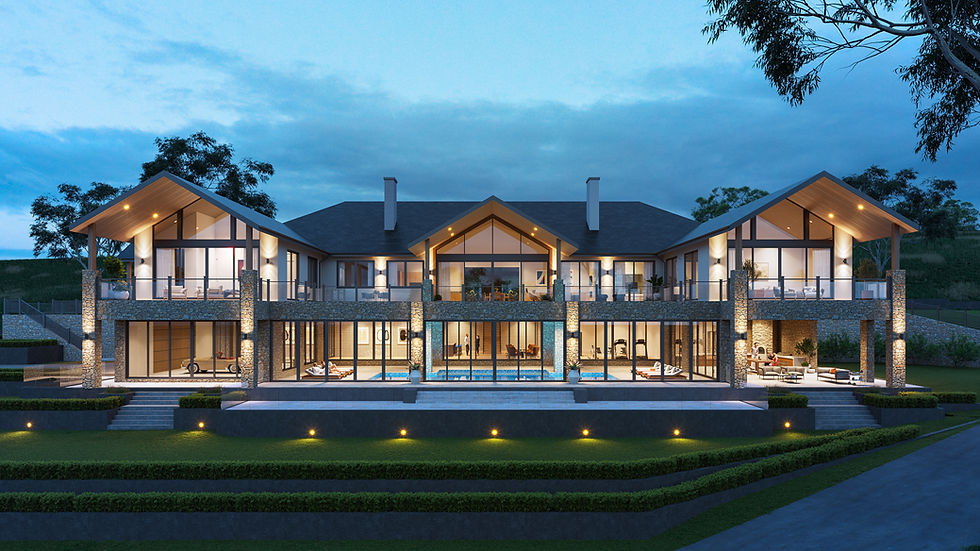Timeless Interior Design
- Architeria Architects

- Jan 17, 2024
- 5 min read
Updated: Nov 21, 2024
By Kate Gawi, Architeria Interiors
Interior design has many different faces; the classic interior design, the modern, mid- century modern, the transitional, coastal, contemporary, and eclectic to name a few.
Different styles are often linked to certain eras and just as with fashion, interiors too tend to go out of style. The world that we live in today is ever changing. Social media and interior design shows on TV are constantly bombarding us with new styles, new trends and colour schemes so it could be quite the challenge to create a home that you wouldn’t want to change after some time. Having a home that feels dated because you used to obsess over a certain style, colour scheme or finishes that no longer seems to fit your lifestyle, is not that fun.
Choosing to decorate your space in a certain style can be a costly exercise down the track when that industrial loft design no longer feels fresh and exciting, just as you would feel wearing shoulder pads from the eighties.

Architeria Architects design timeless homes and as such, Architeria Interiors, create timeless and often traditional and transitional interiors. Our aim is to create spaces that last.
When we think timeless, we think old world, steady, elegant, and classic. Without going too ornate and too “old”, sometimes transitional interior design is the way to go to create that sense of timelessness. Transitional interiors are a combination of a more traditional style and a modern and comfortable style, where we mix design elements to create a perfect balance of classic and current.
A timeless interior ooze of confidence and pride.
The key is to create a more relaxed environment, taking the edge off a strictly formal design and incorporate details to modernise the space.
Traditional interior design draws its inspiration from stately European homes. Details, patterns, and antique furniture from the Georgian, Regency or Louis XV eras are often to be used. The use of ornate mouldings, wainscoting and coffered ceilings in those eras were common and if you are lucky to preserve a period home and restore it to its former glory, you would cherish these intricate details.
Designing a new home requires careful consideration of the use and combination of these elements and having access to an interior designer who lives and breathes traditional design is a great advantage.
Striking the right balance, without re creating a specific era, nor overly modernising a space, is vital. Incorporating all modern amenities, considering the needs of the occupants, and yet creating that timeless feel can be achieved by carefully curated compilations of furniture and other elements. Sometimes what it takes, is a bit of boldness and thinking outside the rules.
Being too true to be following a certain design style will not allow for a timeless design to fully flourish and flow. Adding some glamorous and more modern pieces to your furniture and mixing them up with the more traditional pieces is often a successful approach to the timeless. However, there still needs to be a rhythm and a thread running through your design. Repetition of a pattern or a finish is still key to tying the design in. When choosing your furniture, allow for future changes.
Which pieces would you invest in to keep? The antique, good solid pieces are timeless and keepers for sure. Just be mindful of cost, as it is a lot cheaper to replace soft furnishing and decorative objects than it is to replace that stone console that you now have outgrown. The point here is that some trends come and go, so it is worth investing in longer lasting and traditional pieces than spending a fortune on a modern piece that gives you the yikes a few years down the line. Traditional carpets are timeless. A good silk rug will stand the test of time, so keep the colours as neutral as possible.
Keep the proportion right. When mixing furniture styles this is particularly important. A robust mahogany piece may not be looking its finest next to a fragile Louis XV settee so perhaps find a home for the settee in another room where it isn’t competing with the more robust piece of furniture. Even when mixing the current furniture with the older ones, it is important to keep the proportion right.
Traditional patterns such as plaids, damasks, and stripes fit particularly well and keep the patterns repeated in different applications. I wouldn’t overdo florals unless used in a wallpaper, designed to suit a room. The use of wallpaper above dado rails or inside the inlay mouldings is a wonderful way of creating style.
Darker paint colours in a home office along with some brown chesterfield chairs combined with and oversized, statement piece stone desk and some carefully picked chandeliers and picture frame lights never fail to impress.
When it comes to the finishes, many traditional homes use a hardwood flooring which to date, is an excellent design choice regardless of the style. Many traditional, older homes have a more toned and often polished flooring. When creating a timeless design, we love to lighten the spaces up a bit by choosing lighter wood colours but keeping the formality by using a herringbone or a chevron pattern or by using border planks, separating spaces. It is, yet again, about the balance between formal and current. Sophisticated is a word we ae aiming for.
The same principle would apply to fixtures. How ornate would you go with your taps and joinery? There is a huge selection of profiled doors available and to find a timeless profile and not go overboard with your corbels and keystones is key so to speak. Sometimes replacing a Victorian cupboard knob with a plainer one but changing the finish of it to gold or polished nickel can make a big difference. Sometimes it is in the smallest of details. Often adding some trims in metal can bring the design a touch of modern. It is worth noting that any metal that looks flimsy is a no-no. Lights should be stately and make a statement and large chandeliers are an obvious choice.
Kitchens and bathrooms are some of the spaces that need extra consideration. In the current market there are so many countertop materials and patterns available and there always seem to be a trend in marbles and their patterns and colours that feels a bit tired and overdone after a while. Choose neutral. Choose the cream or white or the light grey. Keep your kitchen doors white. Not necessary a bright white, there are plenty of fantastic neutrals and off whites to choose from. Search the internet, it is flooding with images of fantastic Benjamin Moore whites for classic kitchens. Who hasn’t drooled over a safe, but perfect black and tan scheme?
Timeless interiors are comforting. When you walk into a space, it should feel like it is constant. It should feel safe, assertive, and elegant at the same time. It should talk to generations and be easy to refresh with minimal efforts and not fearing the future.
For your timeless interiors, contact Architeria Architects on 03 9894 5805






















Comments